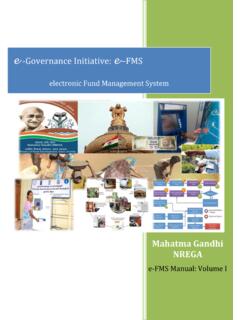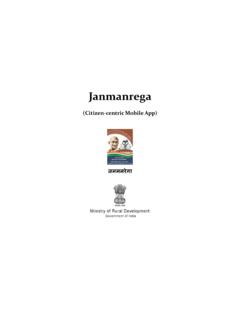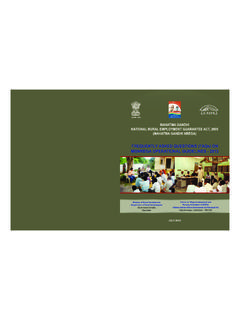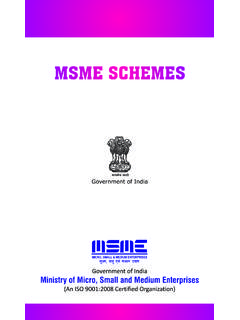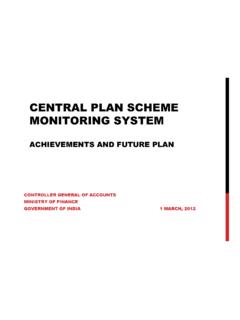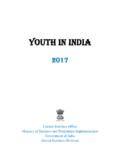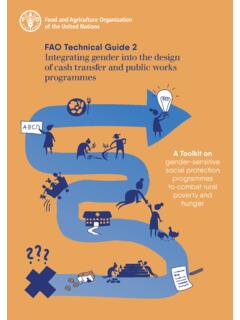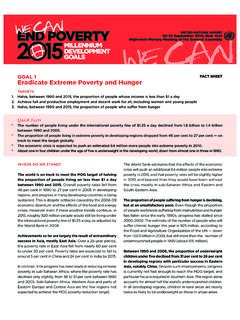Transcription of electronic Fund Management System - mgnrega.nic.in
1 Mahatma gandhi NREGA e-FMS Manual: Volume I e -Governance Initiative: e FMS electronic Fund Management System Ministry of rural Development (MGNREGA) e-FMS document 2 Table of Contents 1 Introduction .. 3 Project Background .. 3 Real-time Transaction-based System for MGNREGS .. 4 MGNREGA Implementation challenges .. 4 Project Implementation Approach .. 5 e-FMS Project Objectives: .. 6 2 Existing System .. 7 Activity Flow .. 7 3 Proposed System .. 8 Activity Flow .. 8 Solution Components & Stakeholders .. 9 Technical Architecture .. 10 4 Geographical Scope .. 13 5 e-FMS Implementation Approach .. 14 e-FMS: Phase-I .. 14 Pre-requisites for States .. 14 Activities .. 15 Requirements .. 16 Limitations .. 17 6 e-FMS: Steps Involved: .. 18 7 e-FMS Detailed Process: .. 25 8 e-FMS Monitoring through NREGASoft .. 40 9 Reports on e-FMS .. 41 Ministry of rural Development (MGNREGA) e-FMS document 3 1 Introduction Project Background The Mahatma gandhi national rural employment guarantee Act (MGNREGA) aims at enhancing the livelihood security of people in rural areas by guaranteeing hundred days of wage- employment in a financial year to a rural household whose adult members volunteer to do unskilled manual work.
2 The Mahatma gandhi national rural employment guarantee Scheme (MGNREGS) came in force on 2 February 2006. Initially, the act was applicable to 200 poorest districts of India. Later, it was extended to another 130 districts in 2007-2008. Since year 2008-2009 its coverage has been extended to all districts of India as per the provisions of MNREGA. The allocated budget for year 2011-12 is around 40,000 Crore for this program. national Informatics Centre (NIC), along with Ministry of rural Development (MoRD) and other stakeholders, conceptualized web enabled Management Information System (MIS), NREGASoft, to address the planning & monitoring needs of the scheme. NREGASoft is a local language enabled, workflow based transaction level System designed for all activities of all stakeholders across the country.
3 It is hosted on MGNREGA portal ( ) and provides detailed information regarding implementation of the scheme. The portal provides public access to about 12 crore jobcards with 24 crore registered workers and around 8 crore muster rolls giving details of daily attendance of workers working on MGNREGA work site along with the amount paid to them. The Ministry relies on the fund utilization information generated through NREGASoft for release of funds to States / Districts. NREGASoft is accessible by all stakeholders providing them a single window interface for all MGNREGA related activities. This System has made a good progress in ensuring transparency by making the various registers, muster rolls, documents, available in the public domain. It is fully compliant with the requirements of the MGNREGA and maintains accounts, generates required registers, documents in the mandated formats.
4 It has also proved useful in tracking the Panchayat-wise shelf of the works/projects, pattern of demand for work, allocation of work, muster-roll, social audit data, track fund Ministry of rural Development (MGNREGA) e-FMS document 4 transfer to various implementing agencies, facilitate information exchange and provide a platform for registering grievances of the workers. Overall, this System has had a positive impact and has been able to provide definitive inputs for planning purposes. Real-time Transaction-based System for MGNREGS While NREGASoft has served well until now, there are new areas of extension, which could help streamline the implementation of MGNREGA. NREGASoft provides transactional capabilities such as demand for work, work allocation, attendance on muster rolls, measurement book, generation of wage list, material procured, administrative expenses, and pay order etc.
5 Though the design of software is capable of being used in fully tied workflow manner, owing to several factors such as ICT capability and availability at GP level, governance processes etc. States have been using it as an MIS alone entering the details when particular phase is over. Also, there are some areas where activities are carried out of Panchayat Office, such as estimates, attendance, measurements and payment, and could be addressed effectively with some handheld ICT device having connectivity and interoperable with NREGASoft. The existing features when coupled with electronic data capturing and electronic fund transfer will provide a robust end-to-end System that will not only hasten the processing but also address some of the other key concerns as detailed in subsequent paragraphs. MGNREGA Implementation challenges Delay in payment of wages has been identified as a key challenge in implementation of MGNREGA.
6 The reasons are primarily: (a) Delay in recording of measurements and calculations thereafter (b) Delay in crediting the accounts of workers (largely payments are routed through Banks/ Post office accounts) and (c) Delay in actual wage disbursal by Banks/ Post offices. While the solution to the problem listed at (c) above lies in increasing the outreach of Banks/ Post office network and is being sorted out through roll out of BCs and improving postal network , issues at (a) and (b) may be addressed through an IT Ministry of rural Development (MGNREGA) e-FMS document 5 solution. The IT solution should automate all processes involved in step (a) and (b) listed above. Capturing all related processes through an IT solution will also make the MGNREGA MIS transaction based. Some of the other challenges are as follows: (a) Management of large number of Bank & Post Office accounts.
7 (b) Parking of fund at various levels (GP, Block, Line departments, District, State). (c) Manual transfer of Payment Orders to Banks / Post Offices thus leading to delay in payment of wages. (d) Delays in transfer of records from Field to the Data Entry location (e) Sometime leads to delay in release of funds from MoRD to States / Districts (f) Wrong / erroneous entries in to the MIS without any checks and responsibilities (g) NREGASoft s existing transactional capabilities being used in a limited way. (h) Inadequate manpower and skills at Field level. To address these, it is proposed to capture data at the grassroots in real-time using latest ICT technology. This would significantly contribute towards achieving the objective of real time flow of information, report generation and inhibiting delays in payments etc. Also, this System will provide a greater degree of control over the funds parked at various levels.
8 It is also proposed to incorporate electronic fund transfer for faster and efficient payments to workers. This report presents the implementation approach, technology solution, process flow, reconciliation mechanism and Management of digital signatures. for enabling real-time transaction-based NREGASoft. Project Implementation Approach In order to meet the above challenges a proposal (Real Time Transaction Based IT solution) was prepared by NIC in consultation with this division. The proposal from NIC contains solution for both (a) Delay in recording of measurements and calculations Ministry of rural Development (MGNREGA) e-FMS document 6 thereafter and (b) Delay in crediting the accounts of workers (largely payments are routed through Banks/ Post office accounts), in two distinct phases: Phase-I will encompass the implementation of electronic Fund Transfer (e- FMS System ) leveraging the Core Banking infrastructure (NEFT/RTGS) of commercial banks.
9 Phase-II will encompass field-level electronic data capture through handheld devices. The handheld device will be used for demand registration, attendance, record the work measurements and will directly upload these to the central MIS (NREGASoft) The implementation of these Phases can be undertaken in parallel, as the Phase-II activities do not have a direct dependence on the Phase-I completion. However, it has been decided to first take up Phase I (e-FMS) only that would address the problem listed at (b) above followed by Phase-II. e-FMS Project Objectives: The specific objectives of the Phase-I e-FMS are as under: e-FMS solution will automate all processes involved in crediting the accounts of the beneficiaries. Reduction in the turn-around time required for wage processing and payments Automation of processes will eventually lead to real-time availability of data at all levels of governance for strategic decision making.
10 E-FMS will act as seamless payment mechanism which will automatically ensure fund transfer and crediting of beneficiaries accounts leveraging the Core Banking infrastructure (NEFT/RTGS) of banks. The System ensure right amount in right accounts in time. Successful implementation of the project across the country would do away with large number of bank accounts that are currently being operated by the Gram Panchayats and other Implementing Agencies all over the country as payments would be credited to the accounts of beneficiaries from an e-FMS Account. This would also take care of the problem of large unspent opening balances. Ministry of rural Development (MGNREGA) e-FMS document 7 This would help streamline the fund flow process. Reduction of workload at Block Program Office (BPO) / Gram Panchayat (GP) 2 Existing System Barring a few states such as Karnataka, Kerala, West Bengal, Tamil Nadu, Himachal Pradesh, and to some extent Gujarat; the entire workflow at GP is manual.
